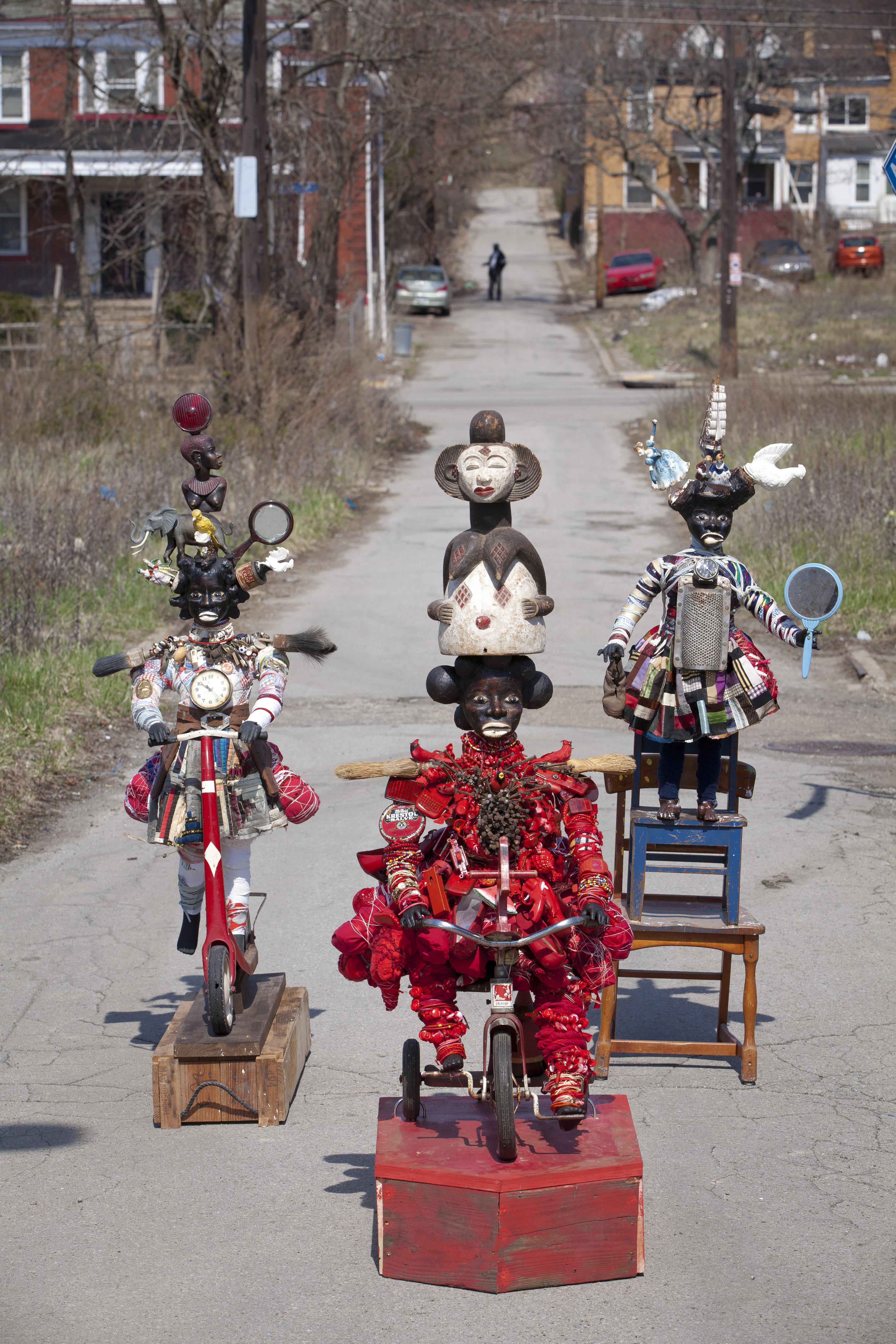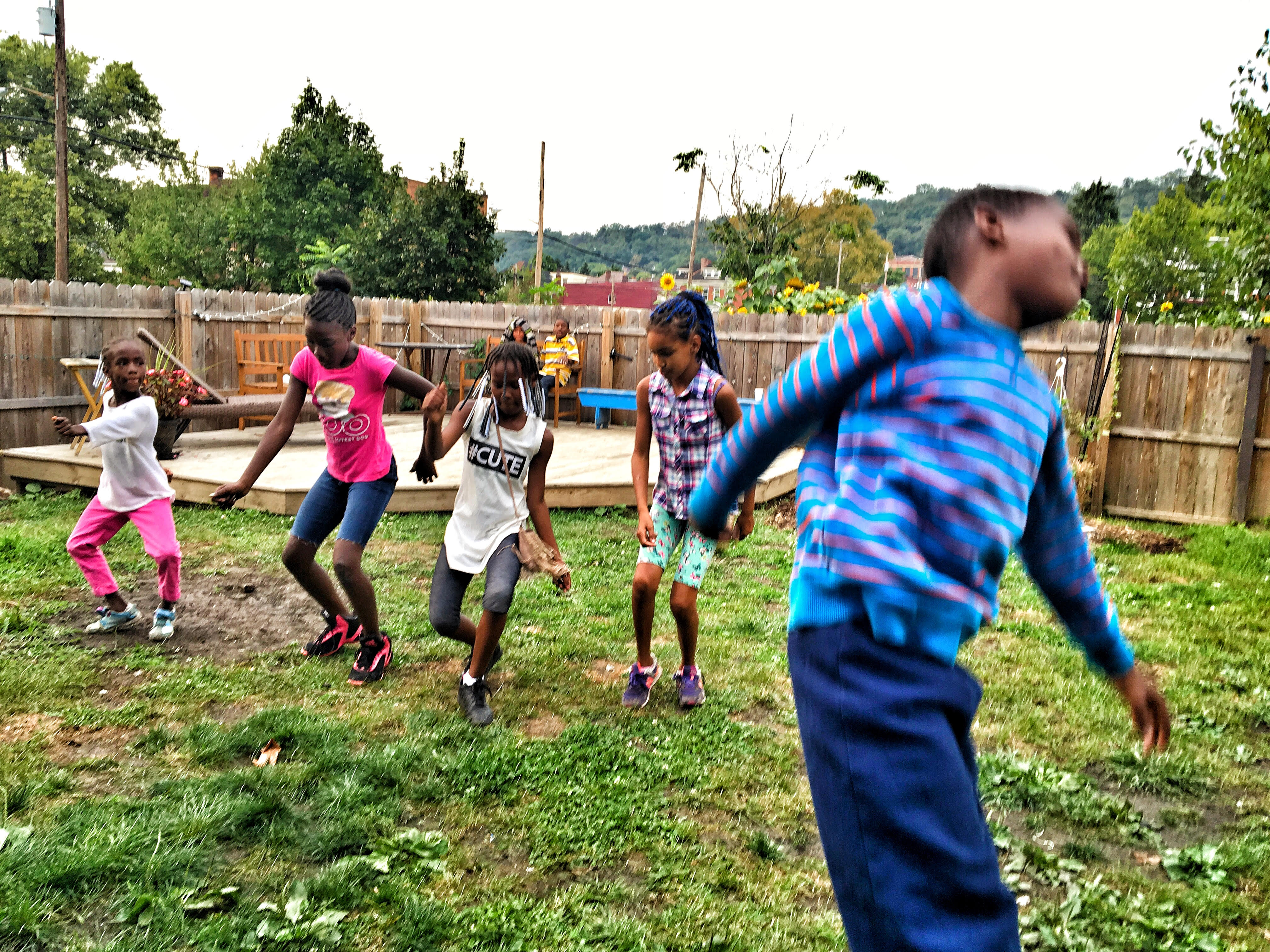Vanessa German’s signature sculptures, or “contemporary power figures”, charge in like an army of truth, sorrow and resilience; standing upon the streets of the historically black neighborhood of Homewood, Pittsburgh, they wear the stories of all those who live and fight there. They become sacred combinations of objects that were once part of locals’ lives, the material remnants of foreclosed homes: bricks, toys, keys, mirrors, and the rubble from the war of gentrification. The creator walks among the holy statues, knowing that they are the soul of the neighborhood.

The figures’ garments are made with seeds of local trees, Homewood seeds, wrapped in bundles of cloth. The figures, all women, embody the strength, sacredness, collective pain and joy of all the lives that make up the neighborhood. Some protest gun violence and the violence of the state upon their community; others just stand, looking beautiful, emanating a long-kept secret. Recently, the power figures were taken to the Wadsworth Atheneum in Hartford, CT, for a solo exhibition called “i come to do a violence to the lie”; however, wherever the sculptures travel, they carry and honor both Homewood and German’s fundamental message of love and affirmation within them.
German’s work has been described as community activism but she rejects the term, and calls herself the more modest yet demanding term “citizen artist”. The sculptor-performance artist-spoken word poet allows art to guide the way she engages with her community and processes the painful politics of living. Her powerful body of work is taking the art world status quo by a storm: a place massively devoid of artists of color, women artists, and queer artists; a place whose exclusion in art is as institutionalized as the segregation of the post industrial city. An antidote to such exclusion, German founded the revolutionary art-making space “Art House” in Homewood.
The Art House, previously called Love Front Porch, is a re-purposed space within a foreclosed home, celebrates the creativity of children and resists the devaluation of gentrification. It does so by creating its own worth through art rather than through the space’s possibilities for production or profit. It is a space for children to make art after school, not as pupils of German but as her equals. It is a place for joy as well as for difficult conversations; for the celebration of life and the vigil of its loss. The Art House is armed with community made mosaics containing affirmative messages such as “being at the art house/ where you realize/ you had wings/ the whole time”.The reimagination of space provoked by Vanessa German’s art house creates a stronghold against gentrification, giving cultural value to a devalued material space based on the values of the original community rather than those of the occupying force. The Art House is armed with the power of love.

Although the Art House was not born from an anti-gentrification agenda, German knows that the space is not innocent. The city of Pittsburgh is allowing the gentrification of neighborhoods deemed undesirable; many of its historically black neighborhoods that had been alive with vibrant cultural scenes are being taken over. People have been driven out to make room for Google, Anthropologie, Whole Foods and luxury apartments. Public housing in the neighborhood of East Liberty, for example, was torn down to make a development with a Whole Foods.
The steel city has adapted from the times of the rust belt into one of “the most livable cities in the country” inviting new settlement. Historically, redlining, dysfunctional public housing, and ghettoization have concentrated poverty and led to over-policing in communities of color. Regardless, the Hill District, Homewood, and East Liberty, to name a few, continue to resist these impositions upon their physical and lived space, imagining and dreaming up their own institutions.The role of all artists is indispensable in this process. The citizen artist is born here.
In addition to its service as a space of cultural production, the House provides food for kids and has a community garden, which helps fight food insecurity and contributes to environmental justice. Author and activist Bell Hooks, in her essay “Homeplace (a site of resistance),” writes that the labor of making a home, spearheading a family and physically and emotionally caring for one’s own in light of the oppressive toll of racism exemplifies an extraordinary form of resistance in African American women.
However, throughout history this resistance is rarely acknowledged. The “Homeplace” narrative harkens back to the Art House if one thinks of it as a sanctuary. German has made the Art House a larger homeplace for her entire community, thus continuing the trajectory of African American women that have had the strength and wisdom to dream up alternative spaces and safe havens to racism and other forms of oppression. Furthermore, being a queer woman and giving children the same respect and agency as adults, she expands the idea of “Homeplace” by establishing a definition of home outside the patriarchal and nuclear family.
The Art House initially began as the Love Front Porch project, born out of German’s everyday exchanges. German would sculpt on her front porch, and curious children returning from school began to want to try art making. She eventually allowed them to paint alongside her, using materials she would recover from houses that were being demolished or renovated; soon, the porch was crowded with young people unleashing their artistic instincts.
German moved the project to a foreclosed home where the children could have more space, and where it could be possible to provide food. In the midst of these endeavors, a shooting occurred as the kids were getting off the school bus, devastating the neighborhood As a response, German began to make signs with messages such as “Don’t Shoot, We Love You” and “Don’t Shoot, Keep Summer Fun,” calling for a safer environment for children. Another incident involved a man being shot right in front of the Art House. German and the community mourned and painted the square where the man was shot in gold. Soon, the Art House became a place where violence could be talked about, processed, and memorialized.
The spirit of the Art House can only become stronger.
Over policing lives on, yet the community lives on. Their hands strike back.
A Target in East Liberty. “Murder and market forces”.
Vanessa German’s army of power figures strikes back. It represents mothers who have lost their children, memories aching to be honored after renovations and demolitions, the creative resilience of love, and the mystical, mysterious, and magical elements of a people who will not be silenced, and will not be devalued.
Photos provided by Vanessa German
